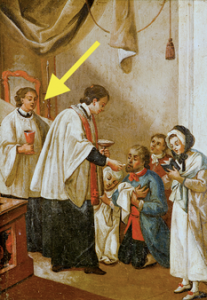 How seriously did our forebears take the reception of Communion and their duty to avoid possible profanation of the Eucharist.
How seriously did our forebears take the reception of Communion and their duty to avoid possible profanation of the Eucharist.
Today I saw an interesting entry at Corpus Christi Watershed about a rubric which disappeared by the time of the 1962 Missale Romanum.
It is curious that in the 1962MR rubrics about certain things disappeared, such as the recitation of the so-called Second Confiteor.
I had forgotten about this rubric. Here’s CCW (in case someone is “triggered” by that, it’s not Concealed Carry Weapon):
As late as 1957, the Roman Missal contained this rubric:
Minister autem dextera manu tenens
vas cum vino et aqua, sinistra vero mappulam,
aliquanto post Sacerdotem eis porrigit purificationem,
et mappulam ad os abstergendum.The Server, however, holding in his right hand
a vessel with wine and water, and in his left a cloth,
a little behind the Priest proffers them
[i.e. the communicants] the purification,
and the cloth to wipe their mouths.
That’s correct: An altar boy followed the priest, giving water and wine to those who have just received Holy Communion.[…]
It seems that this practice fell aside, even as the rubric remained for a time. It was preserved at ordinations and other rare occasions.
The article curiously concludes:
Nevertheless, Fr. Herbert Thurston was probably correct to write, in 1911:
“Nay more, I will go so far as to say that if any priest did carry out the rubric in question, he would—at an early date—have his attention called to the matter by his Bishop, and would be reminded that it was not for private individuals to revive obsolete observances, when they have been suffered to fall into desuetude by a Church fully competent to enforce her own enactments if she wishes to do so.”

































Is that a woman standing in the sanctuary? Looks like she’s singing the communion antiphon.
Given that one often hears about the medieval to recent modern, logistical, difficulty of giving the Precious Blood to communicants, this would seem to have added both formality and difficulty levels. When was it in actual use?
I would point out that we still do this in the East. Wine mixed with water is set out for the faithful (lay and clergy) to take after communion to ensure that no particle of the body of Christ remains in the mouth after communion.
In the East, I haven’t observed wine mixed with water, but wine first and then water in separate cups.
One of the main objections to receiving Holy Communion under both kinds, is that the logistics of distributing the Precious Blood as well as the Host, results in the need for additional ministers — EMHCs.
This practice would have required a similar level of supporting ministers, which (had it persisted), would have invalidated that argument at least.
Dear Fr. Z:
This remains the rubric in the Russian Orthodox Church to this day. After receiving, the communicant walks to a table attended by a server upon which is blessed but unconsecrated wine and antidoron, the portion of the “lamb” not consecrated. The wine and bread is drunk as an ablution.
At the end of the Divine Liturgy, everyone present after kissing the crucifix is given a piece of antidoron to consume. This is a sign or symbol of communion for those not ready at that time (having been unable to confess or not having kept the midnight Fast).
Interestingly, the antidoron at the end of Mass began in the West where it was known as the solatium, consolation for those who could not receive. It is mentioned in St.Augustine of Hippo and other Western fathers. It survives still in France, Quebec, and Italy after High Mass as pain bénit. I recall reading it described in novels as diverse as those by Proust and Balzac.
No matter what your curmudgeon says about rubrics and desuetude, it should be reinstituted and revived everywhere. People should not go to Holy Communion unprepared. The antidoron reminds them in an intense and positive way of what the Mass is about. Children adore it!
My wife who is Russian Orthodox is unable to attend an NO because of the way the eucharist is constantly profaned, by priests, bishops, Popes and the people. In a Russian church, if the antidoron crumb fell on the ground, the old ladies would fall on their knees and its it off the floor.
Yours,
Dan Sexton